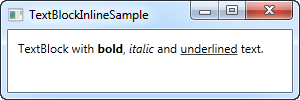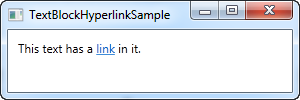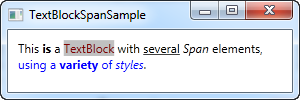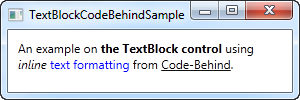WPF教程(十五)文本框——内联格式
来源:互联网 发布:淘宝追加评价怎么看 编辑:程序博客网 时间:2024/05/16 11:29
上章我们学习了文本框最核心的功能:显示字符串,在必要的时候换行。我们还用了其他颜色来凸显文字,如果你想做的远远不止这些,怎么办?
幸好文本框支持内联的内容。这些像控件一样的结构全部继承于内联类,这意外着它们可以作为文本的一部分来传递。支持的元素包括AnchoredBlock, Bold, Hyperlink, InlineUIContainer, Italic, LineBreak, Run, Span, and Underline。接下来我们一个一个来看。
Bold, Italic and Underline
这三个是最简单的内联元素。从名字就可以看出是干什么的,例子如下:<Window x:Class="WpfTutorialSamples.Basic_controls.TextBlockInlineSample" xmlns="http://schemas.microsoft.com/winfx/2006/xaml/presentation" xmlns:x="http://schemas.microsoft.com/winfx/2006/xaml" Title="TextBlockInlineSample" Height="100" Width="300"> <Grid> <TextBlock Margin="10" TextWrapping="Wrap"> TextBlock with <Bold>bold</Bold>, <Italic>italic</Italic> and <Underline>underlined</Underline> text. </TextBlock> </Grid></Window>

和HTML一样,在文本两端加上Bold标签,就可以加粗文字。这三个元素是Span元素的子类,各自实现了具体的属性值来达到预期的效果。如Bold标签设置了FontWeight属性,Italic设置了FontStyle属性。
LineBreak
插入一个换行符。可以参看前面的例子,我们用过。
Hyperlink
超链接用于把链接添加到文本中。它的显示样式由系统主题决定,通常是蓝色的字体带下划线,鼠标悬停时变小手同时字体变红色。通过使用NavigateUri属性来设置你要跳转到的URL。
<Window x:Class="WpfTutorialSamples.Basic_controls.TextBlockHyperlinkSample" xmlns="http://schemas.microsoft.com/winfx/2006/xaml/presentation" xmlns:x="http://schemas.microsoft.com/winfx/2006/xaml" Title="TextBlockHyperlinkSample" Height="100" Width="300"> <Grid> <TextBlock Margin="10" TextWrapping="Wrap"> This text has a <Hyperlink RequestNavigate="Hyperlink_RequestNavigate" NavigateUri="https://www.google.com">link</Hyperlink> in it. </TextBlock> </Grid></Window>

超链接也用在WPF内部的网页,可以在网页之间跳转。这种情况下,你不需要具体处理RequestNavigate事件。但是,如果是从WPF程序加载外部URL,这个事件非常有用。我们订阅RequestNavigate事件后,在加载URL时可以带一个事件处理函数:
private void Hyperlink_RequestNavigate(object sender, System.Windows.Navigation.RequestNavigateEventArgs e){ System.Diagnostics.Process.Start(e.Uri.AbsoluteUri);}允许你使用所有Span元素可用的属性来设置文本的样式。但是Span元素可能包含其他内联元素,因此Run元素可能只包含空文本。这使得Span元素更加灵活。
Span
该元素默认情况下没有具体的形式,允许你设置大部分具体的显示属性,如字体、样式、大小、背景色和前景色等。Span元素最牛逼的自然是可以把其他内联元素放在它的里面,这样就可以联合各种各样的文本了。接下来展示更多Span元素的使用:
<Window x:Class="WpfTutorialSamples.Basic_controls.TextBlockSpanSample" xmlns="http://schemas.microsoft.com/winfx/2006/xaml/presentation" xmlns:x="http://schemas.microsoft.com/winfx/2006/xaml" Title="TextBlockSpanSample" Height="100" Width="300"> <Grid> <TextBlock Margin="10" TextWrapping="Wrap"> This <Span FontWeight="Bold">is</Span> a <Span Background="Silver" Foreground="Maroon">TextBlock</Span> with <Span TextDecorations="Underline">several</Span> <Span FontStyle="Italic">Span</Span> elements, <Span Foreground="Blue"> using a <Bold>variety</Bold> of <Italic>styles</Italic> </Span>. </TextBlock> </Grid></Window>

如果其他元素都非常重要,或者你只想有一个空白的地方,Span元素是最好的原则。
从后台代码来格式化文本
从XAML格式文本非常容易,但是有时候,你会遇到需要在后台代码里实现。这个有点麻烦,来看例子:
<Window x:Class="WpfTutorialSamples.Basic_controls.TextBlockCodeBehindSample" xmlns="http://schemas.microsoft.com/winfx/2006/xaml/presentation" xmlns:x="http://schemas.microsoft.com/winfx/2006/xaml" Title="TextBlockCodeBehindSample" Height="100" Width="300"> <Grid></Grid></Window>
using System;using System.Windows;using System.Windows.Controls;using System.Windows.Documents;using System.Windows.Media;namespace WpfTutorialSamples.Basic_controls{ public partial class TextBlockCodeBehindSample : Window { public TextBlockCodeBehindSample() { InitializeComponent(); TextBlock tb = new TextBlock(); tb.TextWrapping = TextWrapping.Wrap; tb.Margin = new Thickness(10); tb.Inlines.Add("An example on "); tb.Inlines.Add(new Run("the TextBlock control ") { FontWeight = FontWeights.Bold }); tb.Inlines.Add("using "); tb.Inlines.Add(new Run("inline ") { FontStyle = FontStyles.Italic }); tb.Inlines.Add(new Run("text formatting ") { Foreground = Brushes.Blue }); tb.Inlines.Add("from "); tb.Inlines.Add(new Run("Code-Behind") { TextDecorations = TextDecorations.Underline }); tb.Inlines.Add("."); this.Content = tb; } }}
从后台代码是可以实现的,在某些情况下非常必要。然而,这个例子让我们更加意识到XAML的伟大。
- WPF教程(十五)文本框——内联格式
- WPF教程(十四)文本框
- WPF教程(二十五)WrapPanel
- ExtJS教程----自定义金钱格式的文本框
- WPF and Silverlight 学习笔记(十五):WPF命令(Commands)
- WPF and Silverlight 学习笔记(十五):WPF命令(Commands)
- NeHe OpenGL教程 (十五)
- Golang教程:(十五)指针
- 织梦(dedecms)仿站教程第二十五讲——内容页(一)
- WPF教程(一) WPF是什么?
- WPF教程(二) WPF vs WinForms
- WPF教程(四) Hello,WPF!
- WPF教程(八)WPF应用简介
- WPF教程(十三)WPF异常处理
- Jquery系列教程(一)——点击按钮从右至左弹出文本框
- WPF-23:水印文本框
- wpf TextBox日志文本框
- 文本框模拟键盘输入 WPF
- android常用工具类总结
- hibernate —— 一级缓存和二级缓存
- 使用angularjs1.x构建前台开发框架(三)——国际化
- 关于MapReduce join操作
- 2016CCPC东北地区大学生程序设计竞赛 - 重现赛 A - Minimum’s Revenge HDU 5922
- WPF教程(十五)文本框——内联格式
- 重构读书笔记 第3章 代码的坏味道
- HackerRank - Python部分
- ServletContextListener 接口详解
- C Primer Plus学习 四十九 把结构内容保存到文件中
- PyQt学习笔记(1)--Hello World
- codeforces-724
- Java中HashMap的基本用法
- ServletContextListener HttpSessionListener 接口的实现与应用


